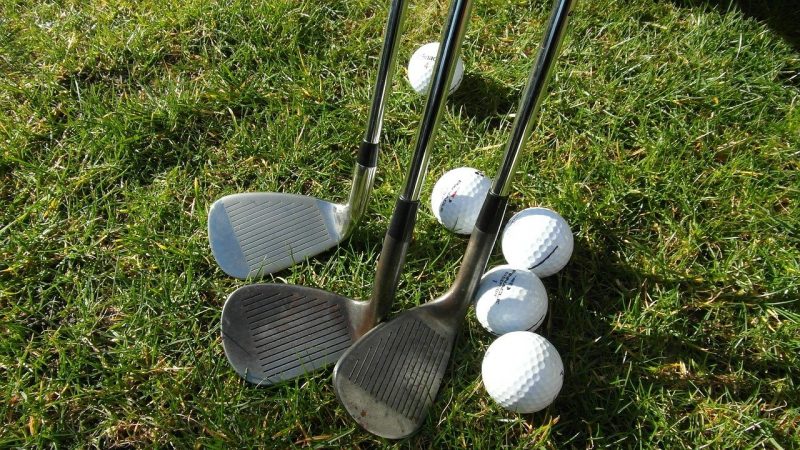Each of the clubs in a golf bag has its own characteristics. As you all know (or should know), the maximum number of clubs carried in a golf bag is 14. With their grips, shafts, and heads, you achieve different distances and a specific kind of stroke with each club. As part of our line-up, you usually carry between 8 and 9 irons (the rest being the driver, one or two extra woods, the putter, and maybe a second wedge). Recently, an amateur golf player asked us: what is the loft angle of irons? And that triggered the idea of writing this piece and answering many explanations here. So, in this article, we will tell you what the loft angle of the irons is about.
To begin, you must know that the loft represents the degree configured on the face of each club. The lowest loft in the golf bag is in the putter, while the highest is in the wedges. Each one has its own specific loft and gives the ball a particular spin. For example, the higher the loft is, the higher the flight the ball will reach.
With regular practice, you get very familiar with what distance and height you achieve with each of the clubs in your bag. In addition, thanks to the loft, you can visualize your strokes with an imaginary line drawn in the air. This means that the suitable loft allows you to make the right shot, depending on the situation, position and lie. As simple as that.
It is usual for beginners to have difficulty understanding what the loft of each golf club consists of. The important thing for those just starting out is to keep in mind that each club in the bag is unique, no matter how similar they are. Therefore, it is essential to know that from the loft of each club and the length of the shaft, the following will be determined:
- The distance of the shot.
- The height that the ball can reach.
- The spin generated.
- The curvature that can be generated.
The loft in the driver and woods is part of a separate chapter. The choice of loft for these clubs depends on several additional factors: the material with which the clubhead is made, how its weight is distributed, and the flexibility of the shaft. In addition, all this has to be in line with the angle of attack that you produce when you hit the ball.
The loft angle of irons
In most cases, the irons approach the ball onto the green. It is the most-used club from the tee box in most par 3s. Similarly, it is your first choice in most second shots in par 4s and as a third shot in par 5s. Each club allows you to cover a certain distance, and the loft is vital in this matter.
The lower the degree, the more distance can be reached with each club. As mentioned before, the loft of the irons is the degrees (opening angle) that the face of the club has, concerning a vertical line perpendicular to the ground.
Most players would usually carry 8 irons in their bag. This would be a classic setup. So, for the most conventional amateur golfers, these are the average distances reached with each club:
- 3 iron (190 yards)
- 4 iron (180 yards)
- 5 iron (170 yards)
- 6 iron (160 yards)
- 7 iron (150 yards)
- 8 iron (140 yards)
- 9 iron (130 yards)
The loft marks the height that the ball will reach in a conventional shot. It is essential to know that the less loft a golf club has, the more difficult it is to get a good impact against the ball. That is why 7-, 8-, or 9-iron shots are always easier than 3- or 4-iron shots.
It is worth adding that each golf brand manufactures its clubs with the appropriate loft based on the club’s configuration. Therefore, you will not always find similar lofts in identical clubs. A TaylorMade 8-iron may have a different loft than a Ping 8-iron and another loft than a Callaway 8-iron. As simple as that.
In any case, the standardization of the loft of the clubs shows us the following:
- Iron 3: between 17° and 21°
- Iron 4: between 20° and 24°
- Iron 5: between 23° and 27°
- Iron 6: between 26° and 30°
- Iron 7: between 29° and 33°
- Iron 8: between 32° and 36°
- Iron 9: between 35° and 39°
The loft of the irons, according to the level of play
Depending on the level of each player, golf irons —along with their loft— are divided into two basic categories: “Game Improvement Irons” and “Player Irons”. The first group consists of irons designed for players to enjoy the game. They are easy-to-handle irons and are much more forgiving to golfers, with technology designed with a more forgiving loft that helps turn bad shots into regular shots. Specifically, they help the ball to have a better flight and trajectory, even if the impact has not been optimal. These irons are often called “Cavity Irons” since they have a niche behind the clubface that improves shots. Meanwhile, the “Players Irons” are usually more closed in face angle, with less loft. These types of irons are used by professionals and low handicap golfers.
